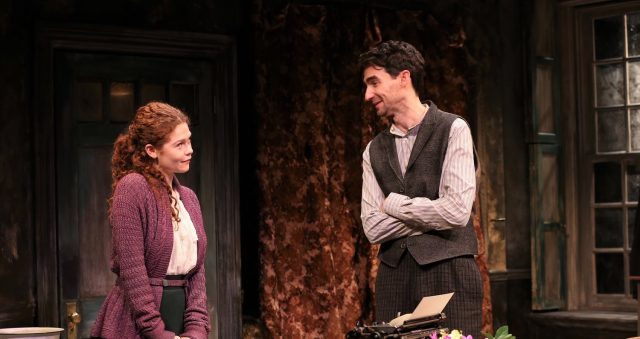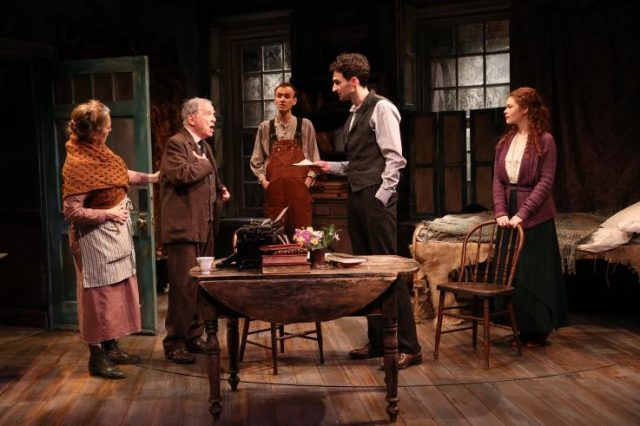
Minnie Powell (Meg Hennessy) and Donal Davoren (James Russell) flirt in Irish Rep revival of Sean O’Casey’s The Shadow of a Gunman (photo by Carol Rosegg)
Irish Repertory Theatre, Francis J. Greenburger Mainstage
132 West 22nd St. between Sixth & Seventh Aves.
Through May 25, $50-$70
212-727-2737
irishrep.org
The Irish Rep’s thirtieth anniversary season, “The O’Casey Cycle,” features Sean O’Casey’s exceptional Dublin Trilogy. Last week I highly recommended Juno and the Paycock the 1924 play set during the Irish Civil War of 1922-23; 1925’s The Plough and the Stars, which takes place around the 1916 Easter Rising, was the first show Irish Rep ever put on, back in 1988, and will begin performances April 20. O’Casey’s first produced play was The Shadow of a Gunman, which premiered at the Abbey Theatre in 1923 and established the laborer as a new force on the scene. The play is set in May 1920, during the Irish War of Independence, in a tenement in Hilljoy Square in Dublin. Small-time peddler Seumas Shields (Michael Mellamphy) is sleeping late, something he appears to do often; while he waits for his colleague Mr. Maguire (Rory Duffy) to go out to sell their wares, a slew of other classic characters from Irish lore, from drunks and ne’er-do-wells to layabouts and overburdened women, come barging in.
Poet Donal Davoren (James Russell) is staying with him, which doesn’t make the landlord, Mr. Mulligan (Harry Smith), very happy, since the rent is overdue. The lovely young Minnie Powell (Meg Hennessy) develops a crush on Donal, believing him to be a heroic IRA gunman preparing for his next hit. “Maybe I am, and maybe I’m not,” he teases, taking advantage of the romantic attention. The blustery Tommy Owens (Ed Malone) stops by to let everyone know that he supports the IRA and will fight if called on. Mrs. Henderson (Una Clancy), who lives in a neighboring tenement, comes over with James Gallagher (Robert Langdon Lloyd), who reads a persnickety letter he wrote asking the IRA for help. And Mrs. Grigson (Terry Donnelly) is worried about her alcoholic husband, Adolphus (John Keating), who talks about himself in the third person. Maguire eventually shows up but is in a hurry, leaving a mysterious black bag with Seumas. Through all the mayhem and madness, the fear that the Black and Tans could show up at any minute hangs over the proceedings with so much dread.

James Gallagher (Robert Langdon Lloyd) seeks help from the IRA in The Shadow of a Gunman (photo by Carol Rosegg)
In the 105-minute two-act play, O’Casey avoids glorifying the lower class. “Upon my soul! I’m beginnin’ to believe that the Irish people are still in the stone age,” Seumas says, adding later, “Oh, this is a hopeless country!” Donal complains, “The people! Damn the people! They live in the abyss, the poet lives on the mountaintop . . . The poet ever strives to save the people; the people ever strive to destroy the poet. The people view life through creeds, through customs, and through necessities; the poet views creeds, customs, and necessities through life.” However, The Shadow of a Gunman is a slighter play than Juno and the Paycock, a less-layered tale lacking the same nuance and muscle. Charlie Corcoran’s fabulous tenement set, which runs throughout the theater, is only slightly altered from Paycock’s. Directed by Ciarán O’Reilly, who plays Capt. Boyle in Paycock, Gunman features many of the same actors, with Hennessy standing out as the coquettish Minnie and Donnelly reprising her role from the company’s 1999 production. In many ways, O’Casey’s vision of the country is personified by Seumas, who doesn’t want to get out of bed in the morning and does not want to go to work. “A land mine exploding under the bed is the only thing that would lift you out of it,” Donal says. It’s a funny line, but one more than tinged with seriousness.